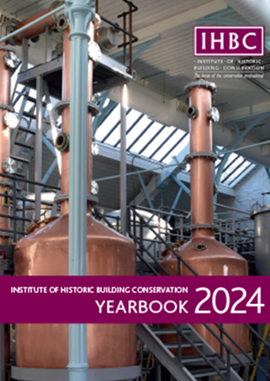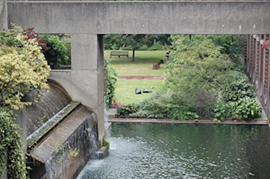Lime mortars vs. cement
Contents |
[edit] Lime Mortars vs. Cement Mortars: Key Differences
When considering construction materials like lime mortars and cement mortars, it's common for individuals to struggle to understand the difference between these useful but distinctly different types of mortars.
With a few decades of experience in building conservation under our belts, we’ve seen a range of diverse mortars from across the globe. This guide aims to explore the different types of mortars, including lime, earth, and cement mortars, clarify their differences, and offer useful indicators for identification.
Before delving into the specifics, it’s essential to acknowledge that while visual indicators are a helpful starting point, these can only get you so far. To correctly pinpoint or identify a mortar without laboratory analysis is challenging, as these binders may feature several similarities.
Therefore, this guide serves as a basic introduction rather than a comprehensive methodology for mortar identification.
[edit] Types of mortars and their historic uses
As we will explore below, the most common types of mortars include:
- Lime mortars
- Natural cement mortars
- Earth mortars
- Portland cement mortars
- Portland cement and lime mortars
If you’re considering using these materials in a construction project, it's crucial to understand the historical contexts in which they have previously been utilised. From ancient lime mortars to the advent of modern cements, each type reflects a unique chapter in the evolution of construction practices. Let’s first look at the different types and historical uses of cement and lime mortars.
[edit] Lime mortars
Lime mortars have a long history, dating back thousands of years, and remain vital in the repair and conservation of traditionally build structures. Throughout British architectural history, lime mortars were commonly used in structures made of stone, brick, or earth. At Cornish Lime, we stock a range of lime mortars.
Whilst remaining in common use in the construction of buildings, the reality is the composition of these mortars varied depending on the era and location. In the pre-1800s and early 1800s, quicklime mortars were prevalent. These mortars involved mixing quicklime with coarse sand and water to create a slaked lime mixture. Analysis by the Scottish Lime Centre found that about four-fifths of mortars from this period followed this method.
With advancements in kiln technology and industrial transport during the 1800s, the usage of natural hydraulic lime (NHL) mortars surged. Predominantly sourced from regions like the Blue Lias belt, these NHL mortars present identification challenges, often requiring mortar analysis for definitive determination.
For those fascinated by historical structures, our article on the Historic Use of Lime in 10 Traditional Buildings & Landmarks offers further insights.
[edit] Natural cement mortars
Natural cements, patented by James Parker in 1796, experienced significant adoption across the United Kingdom in the following century as new source rocks meeting mineralogical requirements were discovered.
These cements, known for their binder-rich composition and distinctive colouration, often resembling red or orange iron oxide hues, offered a contrast to lime mortars, which derive their colour primarily from the sand used.
Notable examples of natural cement applications can be found in London, where both mortars and renders can still be found on prominent buildings even now. Over time, aged natural cement renders may develop hydraulic cracking, reminiscent of the shrinkage patterns seen in arid riverbeds.
[edit] Portland cement mortars
In addition to natural and earth mortars, the history of Portland Cement also merits attention. Developed in the 19th century, Portland cement revolutionised construction practices becoming the first widespread artificially created binder.
Named after the creamy colour of Portland stone, this material is now understood to likely have been similar in strength to one of the stronger modern NHL5 limes. When looking at the chemistry of these materials, it can be easy to confuse a strong hydraulic lime mortar with an early Portland cement.
[edit] Earth mortars
Conversely, earth mortars, fashioned from locally sourced subsoil materials, represent a traditional yet pragmatic alternative. While prevalent in locales with limited access to lime, earth mortars may incorporate the addition of quicklime, evident through the presence of soft, white, powdery lime inclusions.
Typically, the incorporation rate of lime in earth mortars is lower compared to its usage in sand and lime mortars.
[edit] Differences in identifying lime vs cement mortars
Identifying the distinction between lime and cement mortars is essential for anyone involved in historic restoration or renovation projects. While visual examination provides initial clues, identifying the sometimes-subtle differences often requires an experienced eye and, in some cases, professional analysis.
Here are some key indicators to help differentiate between lime and cement mortars:
- Texture and Colour: Lime mortars tend to display a range of pastel hues, influenced primarily by the sand used, while cement mortars are predominantly grey, with variations introduced by additives or pigments. Lime mortars are lower in air content and generally more powdery and crumbly than cement mortars.
- Inclusions: Lime mortars may contain soft, white, powdery lime inclusions, especially in mixes utilising quicklime or hydrated lime. These inclusions are less common in cement mortars but can still occur in certain blends.
- Historical Context: Consider the historical period and regional building practices. Lime mortars have been used for centuries and are prevalent in older structures, particularly those constructed before the widespread adoption of cement-based materials in the 20th century. When considering the age of a building we often find the thicker the wall, the older the building. Here in Cornwall, where thick solid walls were helpful in exposed coastal areas, we've seen walls nearly 2m thick.
- Laboratory Analysis: For definitive identification, consider conducting a mortar analysis, which can provide detailed insights into the composition and characteristics of the mortar. This is particularly important for heritage conservation projects or when dealing with unconventional mortars.
When planning a restoration or conservation project, it’s a great first step to first identify the mortars originally used in your building in order to make informed decisions about appropriate materials or methods.
[edit] How to identify lime mortars
Identifying lime mortars involves recognising certain distinct characteristics:
- Quicklime mortars often contain soft, white, powdery lumps known as lime inclusions, formed during the process of slaking of quicklime. These inclusions are easily identifiable upon inspection with a hand lens.
- Additionally, lime mortars may contain remnants of coal or charcoal, leftover from the original limestone calcination process. In regions with early railway infrastructure or industrial coal mining, such as Bristol or Cardiff where it was common to have leftover ash from burning fuels, a lime mortar known as an ash mortar is common.
- These mortars often have a charcoal grey hue and may lack aggregate, relying solely on lime, coal and ash for composition.
[edit] How to identify cement mortars
Similar to their lime mortar counterparts, identifying cement mortars should begin with visual indicators before progressing to laboratory analysis. It’s worth noting here there is a distinct difference between a historic cement mortar and a contemporary cement mortar.
- For historic forms of cement, a range of colours may present themselves, but early cements were often Portland stone to Bathstone in hue.
- Modern Portland cements exhibit a predominant grey hue and smooth surface texture.
- White cement variations, often blended with hydrated lime for decoration, mimic lime mortars to the untrained eye but display distinct differences in strength, texture and water absorption.
- Under microscopic examination, Portland cement exhibits a glasslike appearance, contrasting with the powdery, fluffy texture of lime binders.
[edit] What is a mortar analysis and what information can it uncover?
Following a preliminary visual inspection, mortar analysis can be both a practical and insightful first step in determining the composition of a lime mortar, render, or plaster. Although not mandatory for most residential buildings, these insights can help inform a project's next steps, appropriate products or application methodologies. Learn more about Cornish Limes Mortar Analysis Service.
Mortar analysis is particularly vital in heritage or listed building conservation efforts. Knowing more about the mortar can aid in securing legal approvals for property renovations or repairs, and inform or justify the selection of materials.
While conventional wet bench analysis methods suffice for listed building consent applications, more in depth and accurate methodologies, such as thin section, soluble silica testing, and XRD analysis, offer deeper insights into mortar compositions.
[edit] Comparison |
[edit] Lime Mortar |
[edit] Cement Mortar |
| Timeline | Used for tens of thousands of years. | Developed in the 19th century and refined in the early 20th century. |
| Composition | Typically made from lime, sand. Can also include earth, hair, fibres and sometimes additives. Historic examples can include blood, beer or even glutinous rice. | Most modern Portland cement mortars are made from Portland cement, sand, a plasticiser and water. You will also see Portland cement, lime and sand mortars and historically Portland cement, Quicklime and sand. |
| Slaking Process | Slaked with the addition of water. | Does not require slaking. |
| Inclusions | May have lime inclusions, appearing as soft, white, powdery lumps. | Lime inclusions are rare, but not unheard of in mortars containing quicklime or hydrated lime but these are few and far between. |
| Colour | Colour is chiefly defined by the sand used unless a pigment is added. Most often pastel colours, such as cream or beige but can be stronger in reds, browns or yellows. | Predominantly a strong grey colour for most applications. However, white cement is often used in decorative elements which pull through the colour of the sand. |
| Texture | Typically has a more crystalline and fluffy texture. | Often vitreous and dense. Modern cement mortars will also often show bubbles from air entrainment. |
| Strength | Generally softer, flexible and more porous. However, this will depend on the type of lime. | Typically very strong, hard and brittle. |
| Water Absorption | Generally more breathable and porous. | Less breathable, often impervious. |
| Applications | More appropriate for solid walled historic buildings. | Most appropriate for modern cavity construction. However, early cements were used throughout the Victorian period for solid walled construction. But these cements bear little resemblance to modern cements today. |
In summary, understanding the distinctions between lime and cement mortars is crucial for preserving historic structures. Lime mortars, with their long-standing tradition and reputation for breathability, play a vital role in maintaining the integrity of historical buildings by working harmoniously with traditional construction materials.
By recognising these differences, professionals can make informed decisions when undertaking restoration or conservation projects, ensuring the longevity and authenticity of our architectural heritage.
[edit] Related articles on Designing Buildings
- Binding agent.
- Cement mortar.
- Defects in brickwork.
- Defects in stonework.
- Dry hydrate lime mortar.
- Grout.
- Gypsum.
- Harl.
- Hemp lime construction: A guide to building with hemp lime composites.
- High alumina cement.
- High lime low alkali glass.
- Hot-mixed lime mortar.
- Hot-mixed mortars: the new lime revival.
- Hydraulic lime.
- Hydrated lime.
- Lime concrete.
- Lime mortar.
- Lime plaster.
- Lime putty mortar.
- Lime run-off.
- Mortar.
- Mortar analysis for specifiers.
- Non hydraulic lime.
- Pointing.
- Portland cement.
- Rendering.
- Soda-lime glass.
- Stucco.
- Types of mortar.
- The use of lime mortar in building conservation.
- Types of mortar.
IHBC NewsBlog
Crystal Palace Subway, for 160th anniversary
The remarkable Grade II* listed Crystal Palace Subway in South London begins a new era following major restoration.
National Trust brings nature back to an area twice the size of Manchester in less than a decade
The National Trust has achieved its aim of creating or restoring 25,000 hectares of priority habitat on its land by 2025.
18th-century hospital in York to become sustainable homes
A former mental health establishment founded by a Quaker in 1792 is to be converted into 120 energy-efficient homes in York.
Context 180 Released - Where Heritage and Nature Meet
The issue includes life, death, Forests, bats, landscapes and much more.
Church architecture awards 2024: now open
The National Churches Trust has announced three awards, all of which are run in partnership with the Ecclesiastical Architects & Surveyors Association (EASA).
The essential sector guide includes officers' updates and a foreword by EH Chair Gerard Lemos.
Historic England opens nominations for the National Blue Plaque Scheme
The scheme is open to nominations to celebrate people from all walks of life.
Striking photos show nature reclaiming brutalist concrete
‘Brutalist Plants’ explores nature’s links to the architectural style characterised by imposing form and exposed concrete.
Purcell’s guidance on RAAC for Listed Buildings in England & Wales
The guidance specifically focuses on Reinforced Autoclaved Aerated Concrete (RAAC) in listed buildings.
IHBC Membership Journal Context - Latest Issue on 'Hadrian's Wall' Published
The issue includes takes on the wall 'end-to-end' including 'the man who saved it'.




















